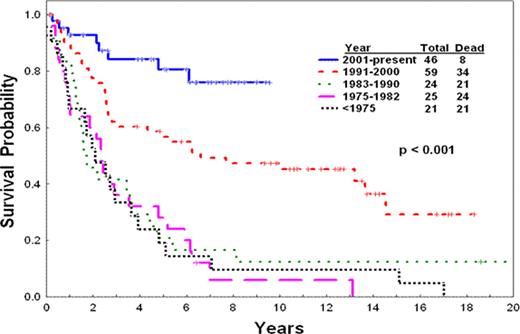Abstract
Abstract 2750
Outcome of CML since introduction of imatinib therapy has improved. Aims: analyze improvement of CML outcome in different phases. Study Group: A total of 1,569 patients with CML referred since 1965, within 1 month from diagnosis, were reviewed and used to identify phase-specific prognostic factors: 1,148 chronic, 175 accelerated, 246 blastic. Results: The median survival was 8.9 years in chronic, 4.8 years in accelerated, and 6 months in blastic phase. In chronic phase, the 8-year survival was ≤ 15% before 1983, 42–65% from 1983 to 2000, and 87% since 2001 (Figure 1). Survival was worse in older patients (p=0.004), but less significant since 2001 (p=0.07). Survival by Sokal risk was significantly different before 2001 (p<0.001), but not since 2001 (p=0.4). In accelerated phase, survival improved over time (p<0.001); the 8-year survival in patients treated since 2001 was 75% (Figure 2). Survival by age was not different in years < 2001 (p=0.09), but was better since 2001 in patients ≤ 70 years (p=0.004). Multivariate analysis derived adverse factors since 2001: older age (p=0.049), increased marrow blasts (p=0.03). In blastic phase, the median survival improved over time (p<0.001), although it is only 7 months since 2001. Conclusions: Survival in CML significantly improved significantly since 2001, particularly so in chronic and accelerated phases. Imatinib therapy minimized the impact of known prognostic factors and Sokal risk in chronic phase, and accentuated the impact of age in accelerated and blastic phases.
Cortes:Novartis: Consultancy; Novartis: Research Funding; BMS: Consultancy, Research Funding; Ariad: Consultancy, Research Funding; Pfizer: Consultancy, Research Funding. Kantarjian:Novartis: Consultancy; Novartis: Research Funding; Pfizer: Research Funding; BMS: Research Funding.
Author notes
Asterisk with author names denotes non-ASH members.



